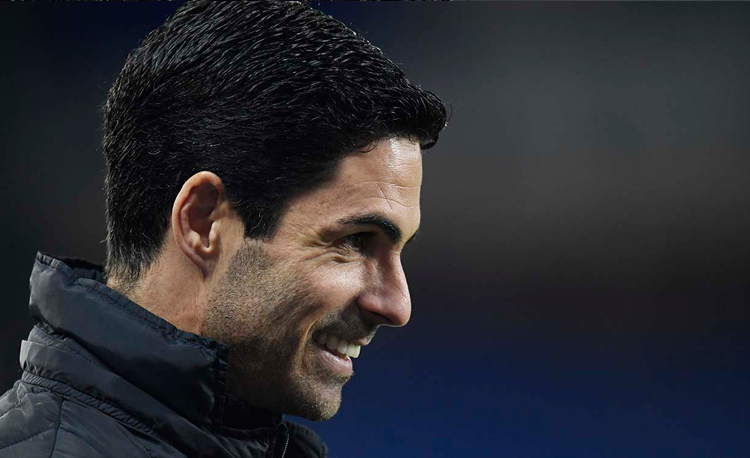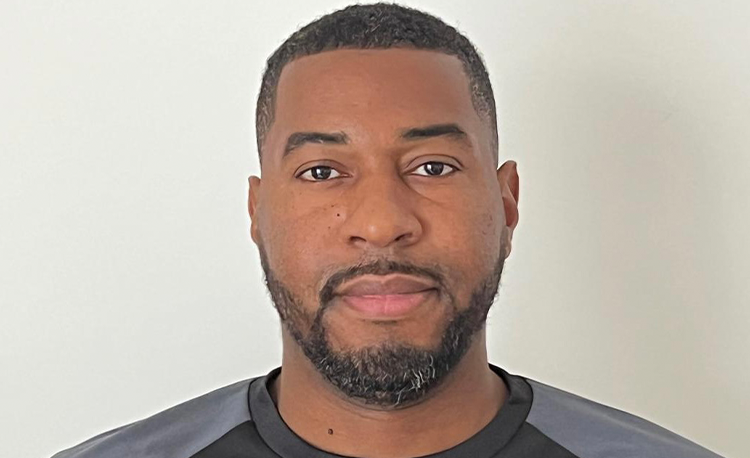This session was run during the international break and it had as its main target the refreshing of some of our key concepts for dealing with different situations in the game. In this instance, the session was a little bit of a mix between defending and attacking, where we focused on defending deep and on a high press in the final third.
| Area | Half pitch |
| Equipment | Balls, bibs, cones, 2 small goals, 2 full size goals |
| No. of Players | Up to 20 players + 2 goalkeepers |
| Session Time |
High press: 20mins, Defending deep: 20mins, Situational game: 20mins, 4v4 games: 20mins |
This session was run during the international break and it had as its main target the refreshing of some of our key concepts for dealing with different situations in the game. In this instance, the session was a little bit of a mix between defending and attacking, where we focused on defending deep and on a high press in the final third.
This varied approach is something that we are not really used to doing because we are more used to focusing on one specific aspect in a training session, whether that be offensive or defensive. But with this session, the main objective was to refresh some of our key concepts.
We wanted to work on specific concepts inside certain game scenarios that we created with each activity. We wanted to work on the timings and the co-ordination of the high press – when to press, when to cover in the space, how to protect different spaces when the ball is outside and when the ball is inside, about positions in the box when attacking and defending. And we also wanted to focus on the counter-press when we lose the ball in the final third.
Of course, there was also the physical objective of the session – the football fitness aspect. I think it is important that we always try to do short sessions but with a high rhythm and the intensity always has to be at a maximum. We are much more focused on quality than quantity. We do a lot of qualitative work, with a lot of intensity in the drills, and we try to have just small gaps between the activities to help us exploit the time as much as possible. We want to be always playing and always on the move. This way we transmit the rhythm that we want to see used in games. We want to be a high rhythm team and to be always proactive and dominant.
HIGH PRESS
We set up on half a pitch, as shown, with a goal and a goalkeeper at one end. We’re using 15 outfield players, split into a red defending team of seven and a blue opposition attacking team of eight plus the keeper.
The red team is set up in a partial 5-2-3 formation but we are not playing with the centre backs. The high press is to be performed by the reds against the blue opposition team, which is set up in a partial 4-2-2-2 formation (without the front two and with four players creating a square in the central area).
Play starts with a pass from the keeper to the blue team and they build up play from the back. Using a high press, the red team works in the areas shown [1] to put pressure on the ball. We want our players to know the sequence of passes they would face when the opposition tries to beat the press, so we replicate the time we spend pressing the ball and during this time we will face a sequence of passes that we can learn from and react to. This means in a match we can anticipate what will happen when we press high.
1

2. Using a high press, the red defending team of seven works in the areas shown to press the ball. Every player movement is made in relation to the movement off the ball in order to constrain the passing sequences of the opposition
3. Initially the reds must only press the ball, but after an agreed time period they can regain possession and counter-attack the goal
When the blue players build up play from the back, at the beginning the reds (our players) aren’t allowed to regain the ball immediately. They can only do their own specific movements in response to the movement of the ball. After a passing sequence from the opposition of, say, 50 seconds, the reds are allowed to regain the ball and from there they can transition quickly to counter-attacking the goal.
The different time specific sequences we run depend on the different sequences of high press that we have experienced during a match. For example, if we have faced numerous passing sequences of 30 seconds when we have operated a high press, we try to replicate this 30 seconds’ worth of effort in the drill. Generally we would run sequences of around 45 to 50 seconds and the specific movements made by the reds are made in relation to the movement of the ball. This helps us to establish a set of rules guiding how we respond to every movement by the ball.
DEFENDING DEEP
We set up on a third of a pitch with a full size goal and a goalkeeper at one end and two small goals at the other end. We’re using 15 outfield players, set up as shown [2], with three red central defenders who are defending deep in the penalty area against three blue attackers. We set up with a 3+1 defensive structure and a yellow holding midfielder is positioned in front of the defenders in the penalty area as part of the red team. He is in charge of covering the space in the second line.
2
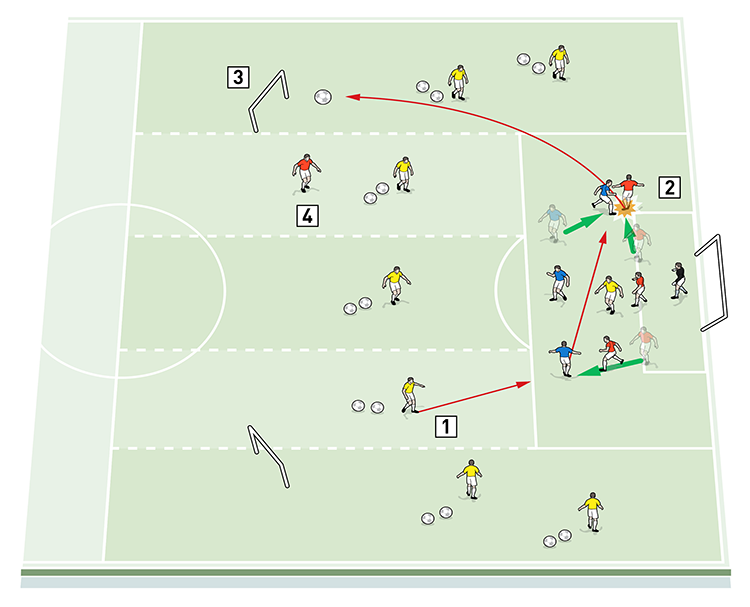
2. Three red centre backs are defending deep against three blue attackers. The reds must defend as a unit. A yellow holding midfielder plays for the reds and can help the red defenders transition to attack if they gain possession
3. The reds must try to clear the ball into the small goal if they win it
4. An optional red player can be positioned up the pitch to give the reds another target for their out ball
We position seven yellow players around the penalty area to feed crosses into the box from different angles. As the balls come into the box, the three defenders must be organised as a unit and move together in relation to the ball, showing the correct body shape and holding their line in a specific place. If the red defenders win possession, they must play the ball into one of the two small goals. The yellow holding midfielder in the box can help the defenders clear the ball if they win possession.
We can progress this activity by adding a red player up the pitch to receive the out ball.
When we ran this session at training we used six centre backs – three as defenders and three as attackers and we rotated them, so each player got to experience both roles. The defenders are constantly under attack in the penalty area and when centre backs are filling the attacking role, it helps the players to understand and appreciate the important things an attacker does in order to beat the defenders.
As coaches, we work with the players on our specific principles of defending and teach them about the zones that we have to defend and about how we defend the man.
We also try to manage the activity in the way that we want it. For example, we would run it a few times with the defensive line reacting to a back pass, because it is important for the defenders to understand when to hold the line and when to stop squeezing.
After the penalty box defence situation, we would work on individual shot-stopping situations, where we would get the players to focus on distance, timing to stop the shot and body position.
SITUATIONAL GAME
We set up for what we call a situational game. It’s not a positional game, it’s a game engineered to create a specific situation that we want to work on – in this instance, it’s one focused on us attacking in the final third against a low block.
We set up on two thirds of a pitch with a goal and a goalkeeper at each end, with the playing area coned off into a funnel shape from defence to attack as shown. We’re using 20 outfield players, split into two teams of 10 plus goalkeepers and we’re coaching the red attacking team.
Play starts with a pass out from the goalkeeper to the red team’s defenders and the reds build up play from the back. Because of the nature of the tapered playing area, the attack starts out quite narrow but fans out until it reaches the opposition penalty area, which will create options for the attacking team who can pass to beat the low block. Players react to the situation confronting them and they can beat the press by passing around it, as shown [3a], or alternatively they can use triangles to pass through it, or they can try other mechanisms that we would use against a back four.
3a
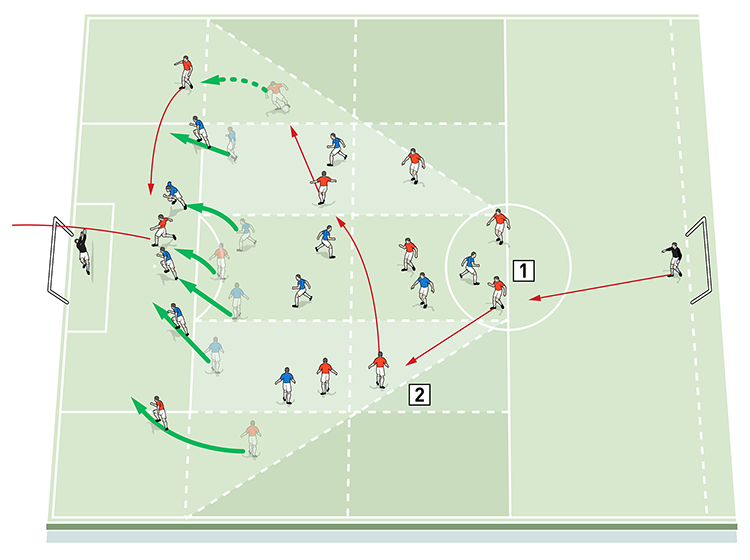
2. The attack starts quite narrow but when the playing area widens out, the possession team has the space to pass around the low block
If the blues win the ball, they can counter-attack towards the narrow end of the funnel, as shown [3b], and the reds must counter-press to regain possession.
3b
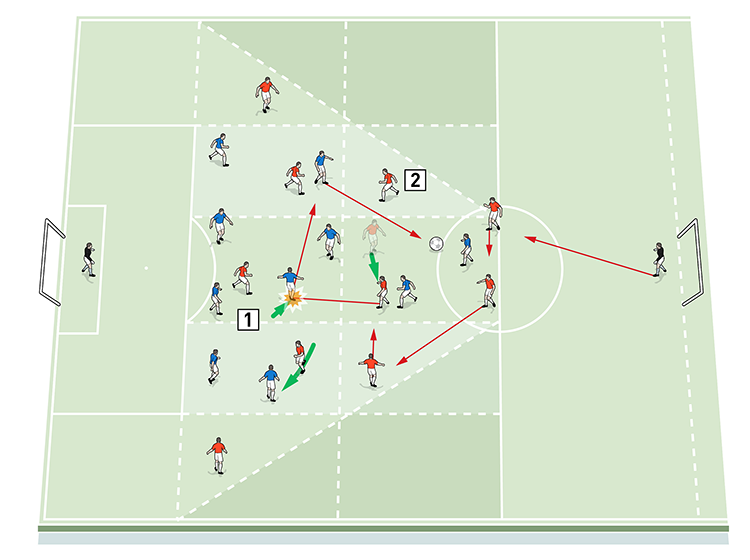
2. The reds must reorganise and counter-press to regain possession
4v4 GAMES
As we ran this session in the international break, we wanted the players to focus on competing and enjoying themselves, so we ended the session with a 4v4 tournament.
We set up a playing area of 32x24 yards with a goal and a goalkeeper at each end. We’re using teams of four players and we run a series of 4v4 games with two simple rules: goals count double if a team wins the ball in the opposition half and they score with a short counter-attack, as shown [4]; and goals also count double if players score with their weaker foot.
4
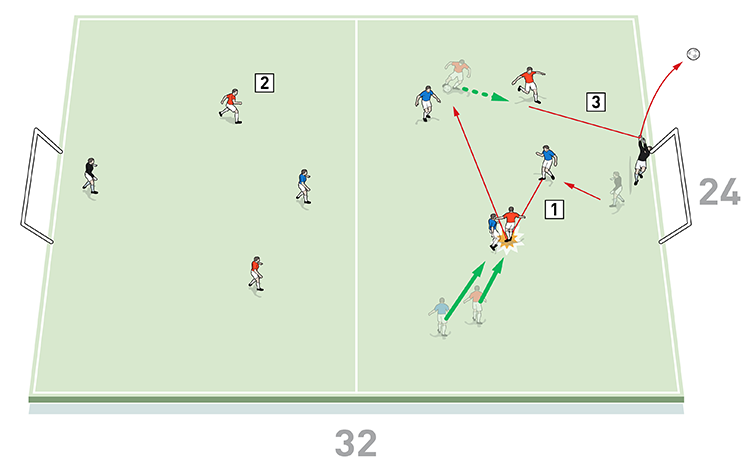
2. The reds have set themselves up in a 2+2 square
3. Goals count double if the ball is won in the opposition half before scoring. Goals also count double if they are scored with the weaker foot
The coaches don’t manipulate the games and put constraints on them to force the kind of situations and coaching points that we’ve been working on through the session, but with our messages we would constantly give them feedback and information to help them create scenarios that were positive for us.
For some parts of it though, we would simply let them play, as to give the players this kind of freedom is really important too. This allows them to manage the different scenarios defensively and lets them decide themselves whether they want to play with a 3+1 defending formation, or in a more diamond shape, or maybe in a 2+2 square.
Related Files
Editor's Picks
Attacking transitions
Deep runs in the final third
Using the goalkeeper in build-up play
Intensive boxes drill with goals
Penetrating the final third
Creating and finishing
My philosophy
Pressing initiation
Compact team movement
Coaches' Testimonials
Coaches' Testimonials
Join the world's leading coaches and managers and discover for yourself one of the best kept secrets in coaching. No other training tool on the planet is written or read by the calibre of names you’ll find in Elite Soccer.
In a recent survey 92% of subscribers said Elite Soccer makes them more confident, 89% said it makes them a more effective coach and 91% said it makes them more inspired.
Get Monthly Inspiration
All the latest techniques and approaches
Since 2010 Elite Soccer has given subscribers exclusive insight into the training ground practices of the world’s best coaches. Published in partnership with the League Managers Association we have unparalleled access to the leading lights in the English leagues, as well as a host of international managers.
Elite Soccer exclusively features sessions written by the coaches themselves. There are no observed sessions and no sessions “in the style of”, just first-hand advice delivered direct to you from the coach.
